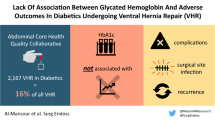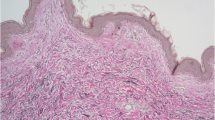Abstract
Background and objective
In diabetics genetic predisposition, poor glycemic control and arterial hypertension contribute to nephropathy development in patients affected by diabetes mellitus. We set up the hypothesis that diabetic nephropathy and incisional hernia formation may have in common alterations of collagen composition and tested whether the occurrence of diabetic nephropathy coincides with wound healing disturbance (incisional herniation) or connective tissue diseases (inguinal herniation, umbilical herniation, aortic aneurysm, varicose veins, disc herniation).
Design
A questionnaire on surgical procedures, wound healing and connective tissue disorders was performed with 731 diabetics. Furthermore, test results for kidney function and damage (creatinine clearance, proteinuria) and blood sugar control (HbA1c) were recorded. Correlations between aforementioned connective tissue diseases and “advanced” diabetic nephropathy were calculated. “Advanced” diabetic nephropathy was assumed in patients with macroproteinuria, CKD stage 5 and/or end-stage renal disease. All diabetics with CKD stages 1 and 2 without proteinuria were included in the “control” group. A subgroup analysis on incisional hernia formation coinciding with diabetic nephropathy was performed in patients with previously performed abdominal surgery.
Results
In patients with advanced nephropathy, some diseases with connective tissue alterations, such as inguinal herniation, aortic aneurysms and varicose veins, did not occur more frequently than in patients without nephropathy. In diabetics with nephropathy, umbilical herniation (3 vs. 8.2 %, p = 0.04) and disc herniation rates (5.7 vs. 16.1 %, p = 0.002) were significantly lower. Subgroup analysis of patients with previously performed abdominal surgery (n = 381) revealed significantly higher incisional herniation rates when “advanced” diabetic nephropathy was present (16 % compared to 5.7 % without nephropathy, p = 0.016).
Conclusion
Our findings support the hypothesis that incisional hernia formation and diabetic nephropathy are positively correlated. Conversely, umbilical and disc herniation pathomechanisms are distinct, as these negatively correlate with the presence of advanced diabetic nephropathy.


Similar content being viewed by others
References
Reidy K, Kang HM, Hostetter T, Susztak K (2014) Molecular mechanisms of diabetic kidney disease. J Clin Invest 124(6):2333–2340. doi:10.1172/JCI72271
Andersen AR, Christiansen JS, Andersen JK, Kreiner S, Deckert T (1983) Diabetic nephropathy in type 1 (insulin-dependent) diabetes: an epidemiological study. Diabetologia 25(6):496–501
Vitiello E, Ferreira JG, Maiato H, Balda MS, Matter K (2014) The tumour suppressor DLC2 ensures mitotic fidelity by coordinating spindle positioning and cell-cell adhesion. Nat Commun 5:5826. doi:10.1038/ncomms6826
Haider DG, Peric S, Friedl A, Fuhrmann V, Wolzt M, Horl WH, Soleiman A (2011) Kidney biopsy in patients with diabetes mellitus. Clin Nephrol 76(3):180–185
Oh SW, Kim S, Na KY, Chae DW, Jin DC, Chin HJ (2012) Clinical implications of pathologic diagnosis and classification for diabetic nephropathy. Diabetes Res Clin Pract 97(3):418–424. doi:10.1016/j.diabres.2012.03.016
Porrini E, Ruggenenti P, Mogensen CE, Barlovic DP, Praga M, Cruzado JM, Hojs R, Abbate M, de Vries AP (2015) Non-proteinuric pathways in loss of renal function in patients with type 2 diabetes. Lancet Diabetes Endocrinol 3(5):382–391. doi:10.1016/S2213-8587(15)00094-7
Boronat M, Garcia-Canton C, Quevedo V, Lorenzo DL, Lopez-Rios L, Batista F, Riano M, Saavedra P, Checa MD (2014) Non-albuminuric renal disease among subjects with advanced stages of chronic kidney failure related to type 2 diabetes mellitus. Ren Fail 36(2):166–170. doi:10.3109/0886022X.2013.835266
Martini S, Nair V, Keller BJ, Eichinger F, Hawkins JJ, Randolph A, Boger CA, Gadegbeku CA, Fox CS, Cohen CD, Kretzler M (2014) Integrative biology identifies shared transcriptional networks in CKD. J Am Soc Nephrol 25(11):2559–2572. doi:10.1681/ASN.2013080906
Boger CA, Sedor JR (2012) GWAS of diabetic nephropathy: is the GENIE out of the bottle? PLoS Genet 8(9):e1002989. doi:10.1371/journal.pgen.1002989
The Diabetes Control and Complications Trial Research Group (1993) The effect of intensive treatment of diabetes on the development and progression of long-term complications in insulin-dependent diabetes mellitus. N Engl J Med 329(14):977–986. doi:10.1056/NEJM199309303291401
Rossing P, Hougaard P, Parving HH (2002) Risk factors for development of incipient and overt diabetic nephropathy in type 1 diabetic patients: a 10-year prospective observational study. Diabetes Care 25(5):859–864
Sheen YJ, Sheu WH (2014) Risks of rapid decline renal function in patients with type 2 diabetes. World J Diabetes 5(6):835–846. doi:10.4239/wjd.v5.i6.835
Zhang Y, Ma KL, Liu J, Wu Y, Hu ZB, Liu L, Lu J, Zhang XL, Liu BC (2015) Inflammatory stress exacerbates lipid accumulation and podocyte injuries in diabetic nephropathy. Acta Diabetol. doi:10.1007/s00592-015-0753-9
Joladarashi D, Salimath PV, Chilkunda ND (2011) Diabetes results in structural alteration of chondroitin sulfate/dermatan sulfate in the rat kidney: effects on the binding to extracellular matrix components. Glycobiology 21(7):960–972. doi:10.1093/glycob/cwr029
Fachinelli A, Maciel Trindade MR (2007) Qualitative and quantitative evaluation of total and types I and III collagens in patients with ventral hernias. Langenbecks Arch Surg 392(4):459–464. doi:10.1007/s00423-006-0086-9
Klinge U, Si ZY, Zheng H, Schumpelick V, Bhardwaj RS, Klosterhalfen B (2000) Abnormal collagen I to III distribution in the skin of patients with incisional hernia. Eur Surg Res 32(1):43–48. doi:10.1159/000008740
White B, Osier C, Gletsu N, Jeansonne L, Baghai M, Sherman M, Smith CD, Ramshaw B, Lin E (2007) Abnormal primary tissue collagen composition in the skin of recurrent incisional hernia patients. Am Surg 73(12):1254–1258
Zheng H, Si Z, Kasperk R, Bhardwaj RS, Schumpelick V, Klinge U, Klosterhalfen B (2002) Recurrent inguinal hernia: disease of the collagen matrix? World J Surg 26(4):401–408. doi:10.1007/s00268-001-0239-5
Adye B, Luna G (1998) Incidence of abdominal wall hernia in aortic surgery. Am J Surg 175(5):400–402. doi:10.1016/j.jvs.2011.02.065
Bode MK, Soini Y, Melkko J, Satta J, Risteli L, Risteli J (2000) Increased amount of type III pN-collagen in human abdominal aortic aneurysms: evidence for impaired type III collagen fibrillogenesis. J Vasc Surg 32(6):1201–1207. doi:10.1067/mva.2000.109743
Raffetto JD, Cheung Y, Fisher JB, Cantelmo NL, Watkins MT, Lamorte WW, Menzoian JO (2003) Incision and abdominal wall hernias in patients with aneurysm or occlusive aortic disease. J Vasc Surg 37(6):1150–1154
Tervaert TW, Mooyaart AL, Amann K, Cohen AH, Cook HT, Drachenberg CB, Ferrario F, Fogo AB, Haas M, de Heer E, Joh K, Noel LH, Radhakrishnan J, Seshan SV, Bajema IM, Bruijn JA (2010) Pathologic classification of diabetic nephropathy. J Am Soc Nephrol 21(4):556–563. doi:10.1681/ASN.2010010010
Fu J, Lee K, Chuang PY, Liu Z, He JC (2015) Glomerular endothelial cell injury and cross talk in diabetic kidney disease. Am J Physiol Renal Physiol 308(4):F287–F297. doi:10.1152/ajprenal.00533.2014
Kamenicky P, Mazziotti G, Lombes M, Giustina A, Chanson P (2014) Growth hormone, insulin-like growth factor-1, and the kidney: pathophysiological and clinical implications. Endocr Rev 35(2):234–281. doi:10.1210/er.2013-1071
Klinge U, Binnebosel M, Mertens PR (2006) Are collagens the culprits in the development of incisional and inguinal hernia disease? Hernia 10(6):472–477. doi:10.1007/s10029-006-0145-8
Lam S, Verhagen NA, Strutz F, van der Pijl JW, Daha MR, van Kooten C (2003) Glucose-induced fibronectin and collagen type III expression in renal fibroblasts can occur independent of TGF-beta1. Kidney Int 63(3):878–888. doi:10.1046/j.1523-1755.2003.00824.x
Junge K, Klinge U, Rosch R, Mertens PR, Kirch J, Klosterhalfen B, Lynen P, Schumpelick V (2004) Decreased collagen type I/III ratio in patients with recurring hernia after implantation of alloplastic prostheses. Langenbecks Arch Surg 389(1):17–22. doi:10.1007/s00423-003-0429-8
Henriksen NA, Mortensen JH, Sorensen LT, Bay-Jensen AC, Agren MS, Jorgensen LN, Karsdal MA (2015) The collagen turnover profile is altered in patients with inguinal and incisional hernia. Surgery 157(2):312–321. doi:10.1016/j.surg.2014.09.006
Hoer J, Lawong G, Klinge U, Schumpelick V (2002) Factors influencing the development of incisional hernia. A retrospective study of 2,983 laparotomy patients over a period of 10 years. Chirurg 73(5):474–480. doi:10.1007/s00104-002-0425-5
Maroz N, Simman R (2013) Wound healing in patients with impaired kidney function. J Am Coll Clin Wound Spec 5(1):2–7. doi:10.1016/j.jccw.2014.05.002
Kursh ED, Klein L, Schmitt J, Kayal S, Persky L (1977) The effect of uremia on wound tensile strength and collagen formation. J Surg Res 23(1):37–42
Kadoglou NP, Daskalopoulou SS, Perrea D, Liapis CD (2005) Matrix metalloproteinases and diabetic vascular complications. Angiology 56(2):173–189
Schaefer L, Han X, August C, Matzkies F, Lorenz T, Schaefer RM (1997) Differential regulation of glomerular gelatinase B (MMP-9) and tissue inhibitor of metalloproteinase-1 (TIMP-1) in obese Zucker rats. Diabetologia 40(9):1035–1043. doi:10.1007/s001250050785
Maeda S, Haneda M, Guo B, Koya D, Hayashi K, Sugimoto T, Isshiki K, Yasuda H, Kashiwagi A, Kikkawa R (2001) Dinucleotide repeat polymorphism of matrix metalloproteinase-9 gene is associated with diabetic nephropathy. Kidney Int 60(4):1428–1434. doi:10.1046/j.1523-1755.2001.00945.x
Kang JD, Georgescu HI, McIntyre-Larkin L, Stefanovic-Racic M, Donaldson WF 3rd, Evans CH (1996) Herniated lumbar intervertebral discs spontaneously produce matrix metalloproteinases, nitric oxide, interleukin-6, and prostaglandin E2. Spine 21(3):271–277 (Phila Pa 1976)
Kang JD, Georgescu HI, McIntyre-Larkin L, Stefanovic-Racic M, Evans CH (1995) Herniated cervical intervertebral discs spontaneously produce matrix metalloproteinases, nitric oxide, interleukin-6, and prostaglandin E2. Spine 20(22):2373–2378 (Phila Pa 1976)
Levine JM, Ruaux CG, Bergman RL, Coates JR, Steiner JM, Williams DA (2006) Matrix metalloproteinase-9 activity in the cerebrospinal fluid and serum of dogs with acute spinal cord trauma from intervertebral disk disease. Am J Vet Res 67(2):283–287. doi:10.2460/ajvr.67.2.283
Park JB, Lee JK, Park SJ, Riew KD (2005) Hypertrophy of ligamentum flavum in lumbar spinal stenosis associated with increased proteinase inhibitor concentration. J Bone Joint Surg Am 87(12):2750–2757. doi:10.2106/JBJS.E.00251
Shimizu M, Furuichi K, Toyama T, Kitajima S, Hara A, Kitagawa K, Iwata Y, Sakai N, Takamura T, Yoshimura M, Yokoyama H, Kaneko S, Wada T (2013) Long-term outcomes of Japanese type 2 diabetic patients with biopsy-proven diabetic nephropathy. Diabetes Care 36(11):3655–3662. doi:10.2337/dc13-0298
Acknowledgments
We are thankful for the collaboration and support with patient recruitment by Dr. Heddeus, Dr. Weidemann and Dr. Böhm.
Funding
The study was supported by SFB/TR57 (Project TP4), SFB854(TP01) and Me1365/9-1 to PRM.
Author information
Authors and Affiliations
Corresponding author
Ethics declarations
Conflict of interest
The results presented in this paper have not been published previously in whole or part, except in abstract format.
Ethical approval
The study protocol was approved by the ethical committee of the RWTH University Aachen.
Rights and permissions
About this article
Cite this article
Loewe, P., Stefanidis, I., Mertens, P.R. et al. Effects of various stages of nephropathy on wound healing in patients with diabetes: an observational cohort study encompassing 731 diabetics. Int Urol Nephrol 48, 751–758 (2016). https://doi.org/10.1007/s11255-016-1229-8
Received:
Accepted:
Published:
Issue Date:
DOI: https://doi.org/10.1007/s11255-016-1229-8




